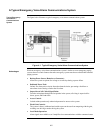
4-3
A command center should be located at the building entrance and act as a communications center
for emergency personnel. The command center is used to display the system status and control the
annunciation system. This area typically includes the equipment required to generate and
distribute messages throughout the building’s emergency network.
Voice paging equipment in the command center typically includes:
• A dedicated master microphone.
• Speaker selection switches (routing switches), used to select paging zones that cover the
entire building or specific areas.
• System auxiliary audio inputs, including remote microphones and connections to other
emergency systems.
• Recorded messages for automatic voice announcements.
• Signal processing electronics.
• Emergency personnel phone equipment.
• Audio riser distribution amplifiers.
Note: It is possible to have multiple command centers within a emergency network, each with a
microphone and speaker select switches. However, only one command center may be in
control at a time, with a clear indication of who is in control.
The audio riser is the wiring that connects the command center with the amplification equipment.
There are several types of risers depending on the application:
• Analog Riser: A system with only one or two channels uses analog risers, where only one
channel is transmitted on a pair of wires. The analog riser uses shielded wire to prevent noise
pickup as it travels throughout the building. It can be configured for Class A or Class B
operation.
• Digital Riser: Applications needing more than two channels use a digital system that
transmits multiple channels of digital audio throughout the building. A single pair of wires is
used to transmit up to eight channels of digitally encoded audio signals. The digital riser is
considered a Signaling Line Circuit (SLC), and is wired in a Style 4 or Style 7 configuration.
• Fiber Optic Riser: The analog riser and digital risers are available with a fiber optic
distribution media. Fiber optic systems have the advantage of immunity to electrical noise
and Earth faults.
A transponder receives the riser from the command center, amplifies and distributes signals to the
speaker circuits. The transponder also interfaces to detection equipment and other signaling
circuits (strobes, deluge valves, etc.) and communicates status back to the command center.
There is typically one transponder for every three floors in a high rise building.
Voice paging equipment included in a transponder is:
• Audio Riser Interface Modules: Receives the riser for distribution to the amplifiers and
includes protection and isolation components.
• Amplifiers: Amplifies the audio signal to produce 25 V or 70.7 Vrms for distribution to
the NACs.
• NACs (Notification Appliance Circuits): Distribution points to the speaker circuits,
provides electrical supervision of opens, shorts, and Earth faults of the field wiring.
The speaker routing switches at the command center are used to selectively turn the NACs on.
Continued on next page
Parts of an Emergency Voice/Alarm Communications System
Command Center
Audio Riser
Transponder


















